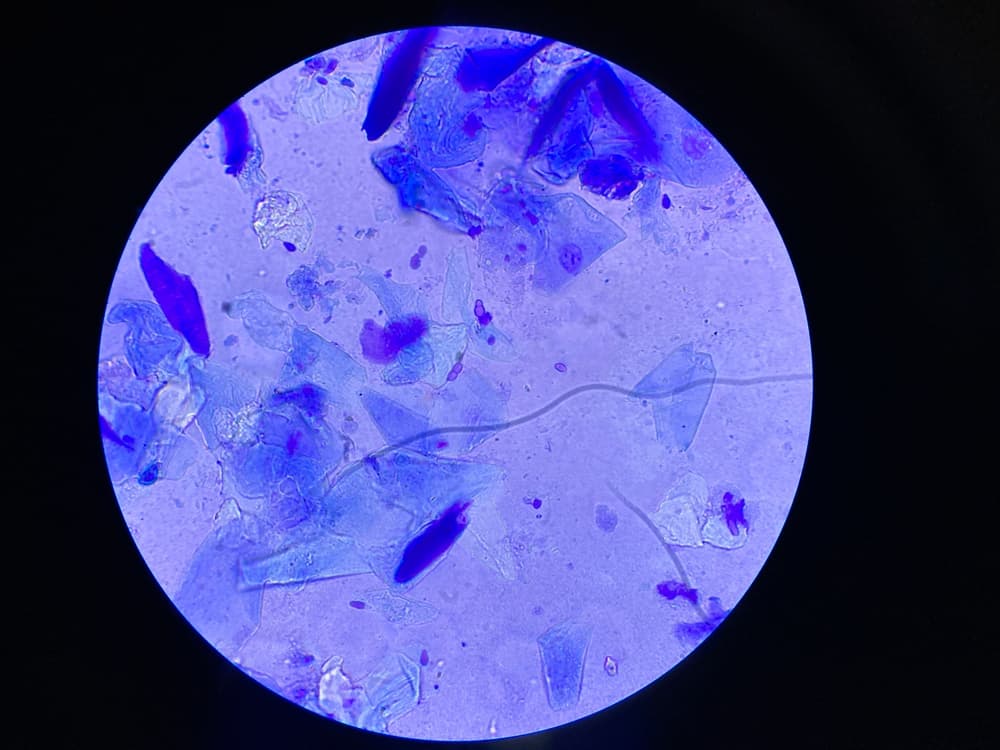Yeast Infections in Dogs

Overview
Certain types of yeast normally live on dog skin and in ears without causing problems and are considered normal flora. When yeast overgrows, however, then it causes itchy, stinky ears and skin. Why does yeast overgrow, and more importantly, how do you stop yeast from causing a problem in your dog? Here’s what you need to know.
Can Dogs Get Yeast Infections?

This section features an affiliate link, meaning GreatPetCare may earn a small commission if you click through and make a purchase.
Yes, dogs can absolutely get yeast infections, and they are very common. Most yeast infections in dogs, including dog skin yeast infection and dog ear yeast infection, are caused by a type of yeast called Malassezia pachydermatis. This type of yeast gets its name from the fact that chronic skin infections with Malassezia cause skin to thicken and darken, making it look like the dog has elephant skin.
What Does a Yeast Infection Look Like on a Dog?
Yeast infections caused by M. pachydermatis create problems with skin and ears. Skin yeast infections in dogs typically affect the lips, feet, belly, armpits, groin, and neck. However, any area of skin can be affected.
How do you know if a dog has a bacterial infection or a yeast infection? One way to differentiate between the two is how your dog smells. Yeast infections typically have a musty odor that, combined with the signs listed below, signals that your dog is having a problem with yeast.
The signs of a skin yeast infection in dogs include:
- Itchy skin, but not always
- Red skin
- Hair loss
- Increased dandruff
- Greasy skin
- Increased odor of skin
- Thickened, black bald skin in long-standing infections (a.k.a. elephant skin)
- May also have concurrent skin bacterial infections
The signs of a ear yeast infection in dogs include:
- Itchy, red ears (head shaking, scratching, rubbing)
- Increased odor of ears
- Black/dark brown debris in ears
Don’t forget, however, that dogs can have yeast and bacterial infections at the same time, and most yeast infections are caused by underlying problems. If you notice dog yeast infection symptoms, it is time to talk to your vet.
What Causes Yeast Infections in Dogs?

Normal dogs with healthy skin and ears do not usually have problems with yeast infections. Dogs develop problems with yeast when they have an underlying skin disease, ear disease, hormonal problem, or if they swim a lot (swimmer’s ear).
While any dog can develop a yeast infection, certain breeds, including West Highland White Terrier, Poodle, Cocker Spaniel, Basset Hound, and Dachshund appear to be predisposed to yeast problems. Additional factors that are risk factors or causes of yeast infections in dogs include:
- Living in an area that is hot and humid
- Having a hypersensitivity condition such as atopy (environmental allergies), food allergy, or flea allergy
- Seborrhea
- Hormonal conditions such as Cushing’s disease or hypothyroidism
- Dogs that have lots of skin wrinkles
Diagnosing Yeast Infections in Dogs

Yeast infections in dogs are diagnosed by a veterinarian. They will use the dog’s medical history and your report of what you notice, a physical examination, and some simple skin tests to diagnose if your dog’s skin or ear problem is caused by yeast. Typically, a veterinarian will take a small sample from the dog’s skin or ear with a cotton swab, stain it, and look at it under a microscope slide. If lots of yeast are noticed, then the dog is diagnosed with having an overgrowth of yeast that is causing skin or ear disease.
If your veterinarian suspects an underlying problem that is causing yeast to overgrow (such as a skin allergy or hormonal condition), they will likely recommend additional testing.
Dog Yeast Infection Treatment: Ways to Manage

Dog yeast infections are treated by reducing the number of yeast with antifungal medication and treating the underlying cause if possible. Remember—if the dog is healthy, yeast don’t overgrow and cause problems.
If your dog only has a problem in their ears or on a small area of skin, then topical antifungal therapy will be prescribed. This can include medicated shampoos, creams, lotions, and sprays.
If the problem is widespread or chronic, then topical therapy and oral therapy with antifungal medication like ketoconazole will likely be prescribed. If your pet is itchy or has inflammation, then steroids or other anti-itch medication may also be prescribed.
If your dog has allergies, then your veterinarian will discuss various allergy treatments with you. If your dog’s yeast infection is caused by a hormonal disorder, then your vet will go over that with you as well. Often, if you manage the underlying conditions, your dog will not have problems with yeast again.
Cost to diagnose and treat a yeast infection typically ranges from $75-$150. This does not include the cost to treat an underlying condition, if present.
Dog Yeast Infection Home Remedy Risks
You may read on the internet that apple cider vinegar or coconut oil will cure a yeast infection, but this is not accurate and may make the problem worse. One at home remedy that you can utilize, however, is hypochlorous acid. Hypochlorous acid (HOCl) is a gentle disinfectant that has antifungal, antibacterial, and anti-inflammatory properties and can be very helpful as an adjunct therapy to manage both skin and ear yeast infections in dogs. HOCl is only effective if it is a stabilized formula, and comes in liquid and in wipes.
How to Prevent Yeast Infections in Dogs
If your dog has problems with yeast infections or you just want to make sure yeast infections DON’T become a problem, there are several things you can do at home to minimize your pet’s risk:
- If your dog has an underlying condition that predisposes them to yeast infections, get that problem managed.
- If your dog swims a lot or has problems with repeated ear infections, instill a few drops of a 1:1 solution of white vinegar and rubbing alcohol after swimming or daily as needed in their ears to dry and acidify the ear canal. Do NOT use this solution if they already have an infection, as the alcohol is irritating to damaged skin. You can also use a hypochlorous acid ear solution as well.
- Use hypochlorous wipes to clean their paws and skin folds daily, or anywhere they seem to have a buildup of yeast. If your dog has seasonal allergies, use the wipes to remove pollen and dust that might be aggravating.
- Give your dog a high quality probiotic daily to balance their gut health, which can help balance health in the rest of the body as well.









